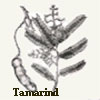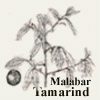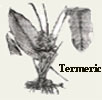|
|
| Herbal
plants and medicinal properties |
|
TAMARIND
Botanical name:- Tamarindus indica
Indian name:- Imli
|
 |
Tamarind
is a large, attractive symmetrical spreading tree. It
has small compound leaves, yellowish flowers with reddish
fleshy and brown fruits. The seeds are dark brown and
shiny. Tamarind is a native of Africa. Its mineral and
vitamin contents are calcium, phosphorus, iron, carotene
and vitamin C. Its calorific value is 283. The pulp contains
tartaric and other acids, sugars like invert - a broken-up
starch, and pectin. An analysis of Tamarind pulps consist
of moistures 20.9 per. cent, protein 3.1%, fat .1% minerals
2.9%, fibre 5.6% and carbohydrate 61.4%. |
|
| Properties:-
The plant has many medicinal virtues. Its leaves are cooling
and antibilious. Pulp o the ripe fruit is beneficial in
the treatment of bilious vomiting, flatulence and indigestion.
It is also useful for constipation. Tamarind pulp, being
rich in vitamin C, is valuable in preventing and curing
scurvy. Tamarind-pepper rasam, a clear soup is considered
an effective home remedy for colds in South India. It
is prepared by boiling a very dilute tamarind water in
a teaspoon of hot ghee and half a teaspoon of black pepper
powder for a few minutes. This steaming hot rasam has
a flushing effect. The pulp of Tamarind fruit is useful
in treating fevers. The Tamarind milk drink as suggested
for fevers, is also very helpful in treating dysentery.
The tender leaves of Tamarind tree are useful remedy for
treating burns. Gargle of Tamarind water is beneficial
in the treatment of sore throat. |
 |
|
TURMERIC
Botanical name:- Curcuma longa
Indian name:- Haldi
|
 |
Turmeric
is a perennial herb 60 to 90 cms high. It has short stem
and raised or lifted branches. Turmeric has been mentioned
in early Sanskrit works. Turmeric is a native of Southern-eastern
Asia. An analysis shows that it consists of 13.1% moisture,
6.3% protein, 5.1% fat, 3.5% minerals, 2.6% fibre and
69.4% carbohydrates. Its mineral and vitamin contents
are calcium , phosphorus, iron, carotene, thiamine and
niacin.
|
|
| Properties:-
Turmeric has many medicinal virtues. The essential oil rhizome
is aromatic, stimulant and a tonic. It is useful in relieving
flatulence. Turmeric is very useful intestinal antiseptic. The
rhizome, its juice or dry powder, mixed in butter milk or plain
water is highly beneficial in intestinal problems, especially
chronic diarrhoea. The juice of raw turmeric mixed with a pinch
of salt is considered an effective remedy for expelling worms.
Turmeric being rich in iron is valuable in anaemia. A teaspoon
of raw turmeric juice mixed with honey is taken everyday in
the treatment of this condition. This herb is beneficial in
the treatment of measles. Turmeric roots are dried in the sun
and ground to a fine powder. Turmeric is an effective household
remedy for bronchial asthma. A teaspoon of turmeric powder with
a glass of milk twice or thrice daily is very effective. |
|